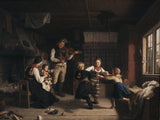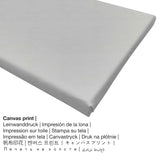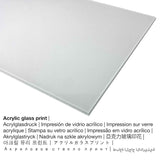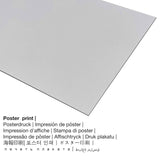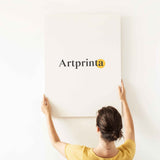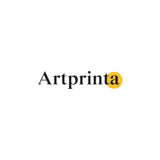Amalia Lindegren, 1860 - mgbede Sọnde n'ụlọ ọrụ ugbo dị na Dalarna - mbipụta nka mara mma
Ụtụ gụnyere. Mbupu gbakọrọ na ndenye ọpụpụ.
Họrọ ihe dị iche iche ihe onwunwe gị
The product dropdown list provides you with the opportunity to select your favorite material and size. Pick your favorite size and material among the following options:
- Ebipụta akwụkwọ mmado na ihe akwa akwa: A poster print is a printed canvas paper with a slightly roughened structure on the surface. The poster print is suited for placing your fine art print in a custom-made frame. Please keep in mind, that depending on the absolute size of the canvas poster print we add a white margin of something between 2-6cm around the painting, which facilitates the framing with your custom frame.
- Mbipụta kanvas: The canvas print, which should not be mistaken with a real artwork painted on a canvas, is a digital copy applied directly on canvas. The advantage of canvas prints is that they are relatively low in weight, which implies that it is easy to hang up your Canvas print without extra wall-mounts. Hence, canvas prints are suitable for any kind of wall.
- Mbipụta iko acrylic (nke nwere ezigbo mkpuchi iko): An acrylic glass print, often referenced as a print on plexiglass, transforms your favorite original into magnificient home decoration. The work of art will be made with the help of modern UV print technology. The special effect of this are vivid and stunning colors. With an acrylic glass art print contrasts and details become identifiable with the help of the delicate tonal gradation of the print. Our acrylic glass protects your selected art replica against sunlight and external influences for several decades.
- Mbipụta nke aluminom: An Aluminium Dibond print is a print material with an outstanding depth. Colors are bright and vivid in the highest definition, the fine details are crisp.
Nkwupụta iwu: We try the best we can to describe the products as precisely as we can and to display them visually in our shop. Nonetheless, the pigments of the print materials and the printing might differ marginally from the representation on your monitor. Depending on your screen settings and the condition of the surface, not all color pigments are printed 100% realistically. Because all the art reproductions are printed and processed manually, there may also be slight deviations in the motif's exact position and the size.
Nkọwapụta izugbe dịka Nationalmuseum Stockholm nyere (© - National museum Stockholm - National Museum nke Stockholm)
Amalia Lindegren var en av det svenska 1800-talets mest folkkära konstnärer, vars verk flitigt reproducerades och som inspirerade författare till dikter och noveller. Populärast var hennes interiörer från Dalarna, miljöer som även för de flesta samtida betraktare måste ha framstått som främmande, men där den borgerliga publiken uppfattade böndernas liv som närmare de ursprungliga ”naturliga” krafterna och känslorna. Redan år 1850 hade Lindegren som första kvinna i Europa mottagit ett statligt stipendium för utrikes konststudier och mellan 1850-56 bodde hon i Paris, Düsseldorf, München och Rom. 1857 gjorde hon tillsammans med konstnärskamraten Jeanette Holmlund en studieresa till Dalarna, som många av tidens romantiskt och fosterländskt inriktade konstnärer. Det var utifrån studier av människor och miljö, främst då i Rättvik, som Lindegren fann sina motiv, med verk som Söndagsafton i en Dalstuga och Lillans sista bädd. Dessa båda målningar är varandras motsatser, den ena handlar om en familjetragedi och den andra om en idyll. I Söndagsafton har hon sökt gestalta en idealfamilj där far i huset spelar polska medan de äldre barnen dansar i ring medan modern sitter med den minste i knäet. I realiteten var det två professionella spelmän som stod modell för fadern. När Artur Hazelius skapade föregångaren till Nordiska museet och Skansen, på Drottninggatan i Stockholm, visades flera stuginteriörer med dockor i naturlig storlek. En av tablåerna var gjord med Lillans sista bädd som förebild. Tablån kom även att användas i den nationella marknadsföringen av Sverige, av det ’typiskt svenska’, på Världsutställningarna i Philadelphia 1876 / Paris 1878 och Chicago 1893. Amalia Lindegrens verk spreds även genom färgreproduktioner och illustrationer i tidskrifter, men också på porslin, sin kanske mest magnifika placering fick Söndagsafton i en Dalstuga på en av Rörstrands påkostade vaser.
Data data
Nke a na narị afọ nke 19 na-ese site na nwanyi Swedish artist Amalia Lindegren in 1860. Ụdị nke masterpiece tụrụ akụkụ ndị a: Ogologo: 88 cm (34,6 ″); Obosara: 117 cm (46 ″) Ekebere: Elu: 115 cm (45,2 ″); Obosara: 144 cm (56,6 ″); Omimi: 11 cm (4,3 ″). Ọzọkwa, artpiece etolite akụkụ nke dijitalụ art collection nke National Museum nke Stockholm - the museum is Sweden's museum of art and design, a Swedish government authority with a mandatet o preserve cultural heritage and promote art, interest in art and knowledge of art. This masterpiece, which is part of the ngalaba ọha a na-enye - site n'ikike nke Nationalmuseum Stockholm na Wikimedia Commons.Ebe E Si Nweta nke ihe osise:. Nhazi ahụ dị n'ụdị odida obodo nwere oke akụkụ 1.2: 1, nke na-egosi na ogologo bụ 20% ogologo karịa obosara.
Iberibe tebụl nka
| Aha nka nka: | "Sunday Evening in a Farmhouse in Dalarna" |
| Nhazi nka nka: | sere |
| Nhazi nka: | nkà nke oge a |
| Time: | 19th narị afọ |
| Afọ okike: | 1860 |
| Afọ nka: | karịa afọ 160 |
| Akụkụ izizi nka: | Ogologo: 88 cm (34,6 ″); Obosara: 117 cm (46 ″) Ekebere: Elu: 115 cm (45,2 ″); Obosara: 144 cm (56,6 ″); Omimi: 11 cm (4,3 ″) |
| Ụlọ ihe ngosi nka / ebe: | National Museum nke Stockholm |
| Ebe ebe ngosi nka: | Stockholm, Obodo Stockholm, Sweden |
| Dị n'okpuru: | www.nationalmuseum.se |
| License: | ngalaba ọha |
| Site n'aka: | Nationalmuseum Stockholm na Wikimedia Commons |
Banyere ihe
| Nkewa edemede: | nka nka |
| Usoro mmeputakwa: | dijitalụ mmeputakwa |
| Production usoro: | Mbipụta UV ozugbo |
| Production: | German mere |
| Ụdị ngwaahịa: | mmepụta ihe na-achọ |
| Ojiji ngwaahịa: | nka mgbidi, foto mgbidi |
| Ndozi onyonyo: | usoro odida obodo |
| Njikwa oyiyi: | 1.2: 1 (ogologo: obosara) |
| Nkọwa nha onyonyo: | ogologo bụ 20% ogologo karịa obosara |
| Nhọrọ dị: | Mbipụta iko acrylic (nke nwere ezigbo mkpuchi iko), mbipụta akwa akwa, mbipụta akwụkwọ mmado (akwụkwọ kwaaji), mbipụta ọla (aluminium dibbond) |
| Mbipụta kanvas (akwa akwa n'elu etiti ihe ndọtị) ụdị nha dị iche iche: | 60x50cm - 24x20", 120x100cm - 47x39", 180x150cm - 71x59" |
| Mbipụta iko acrylic (nwere ezigbo mkpuchi iko) nhọrọ nha: | 60x50cm - 24x20", 120x100cm - 47x39", 180x150cm - 71x59" |
| Mpempe akwụkwọ mmado (akwụkwọ kwaaji) nha dị iche iche: | 60x50cm - 24x20", 120x100cm - 47x39" |
| Ụdị mbipụta aluminom: | 60x50cm - 24x20", 120x100cm - 47x39" |
| Nhazi nke nnomi nka: | agunyeghi |
Banyere onye na-ese ihe
| Aha onye nka: | Amalia Lindegren |
| A makwaara dịka: | Lindegren Amalia, Amalia Lindegren |
| okike onye nka: | nwanyi |
| Obodo onye nka: | Swedish |
| Ọrụ: | onye na-ese ihe |
| Obodo onye nka: | Sweden |
| Nkewa onye nka: | omenkà nke oge a |
| Akwụsị: | 77 afọ |
| Afọ amụrụ: | 1814 |
| Obodo ọmụmụ: | Stockholm, obodo Stockholm, Sweden |
| Afọ nwụrụ: | 1891 |
| Nwụrụ na (ebe): | Stockholm, obodo Stockholm, Sweden |
Nwebiisinka © | Artprinta (www.artprinta.com)

